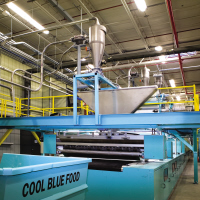Thirteen years in, Interface, Inc. has Reduced its Footprint While Growing the Business
Energy Use Reduced Nearly One-Half; Sales up 27 Percent
Published 04-20-10
Submitted by Interface, Inc.

Through process improvements and energy efficiencies, Interface, Inc. has reduced the energy used to manufacture carpet by 43% since 1996, while greenhouse gas emissions are down 44% in absolute terms, or 94% when factoring in offsets. During the same time period, the company grew net sales by 27%. These energy Ecometrics™ were released today as part of the company's yearlong look at progress to date and what it will take to get to Mission Zero™, the Interface promise to eliminate any negative environmental footprint by 2020.
"Given the growing scarcity of natural resources and the near-certainty that the government will come forward with a cap and trade plan in the U.S., reducing energy use and carbon intensity will continue to be an area of focus for us," said Dan Hendrix, CEO of Interface, Inc. "It just makes good business sense."
Hendrix said that the carpet manufacturing business has changed in many ways since the company began its sustainability journey in 1996, and that sustainability has paved the way to innovation.
"Process innovation like the reduction of -- and in some cases the elimination of -- wet printing through pattern tufting led the way to product breakthroughs like the i2® collection from InterfaceFLOR, the company's best-selling product collection that was inspired by biomimicry but made possible through new tufting technology," explained Hendrix. "On the manufacturing floor, small changes like optimizing line speed and insulating equipment to minimize heat loss have made a big cumulative impact." Hundreds of other changes have allowed the company to reduce its reliance on non-renewable energy sources like propane and natural gas, while green electricity purchases, use of landfill gas and on-site photovoltaic arrays like the one at its Bentley Prince Street facility in Industry, Ca. have boosted the use of renewable energy sources. A full report on the Ecometrics™ can be found here.
Looking ahead to the next 10 years in the company's journey, Hendrix said that further reductions will likely come with collaboration from a growing audience of stakeholders. "The road ahead is more difficult and we'll not only need more innovative technologies; we also need collaboration from every direction -- from suppliers, customers and the governments where we do business," said Hendrix.
Hendrix wrapped up by noting that the company plans a Fall Sustainability Report that will recap progress to date and map out the 10-year road ahead. "We have 13 years of data to use in understanding our progress and evaluating where we need investment, where we need innovation, and where we'll be focusing people and resources as we look to 2020 and beyond."
Last month, the company released current data on its materials strategy, including waste, reclamation and recycling numbers. For more detail on the progress Interface has made in reducing its footprint via energy and emissions efficiencies, visit the global website.
Interface, Inc. (IFSIA) is the worldwide leader in design, production and sales of environmentally responsible modular carpet, manufactured for the commercial and institutional markets under the InterfaceFLOR brand, and for residential markets as FLOR. The company is also a leading designer and manufacturer of commercial broadloom under the Bentley Prince Street brand.
Interface, Inc.
Interface, Inc.
Interface, Inc. is the world’s largest manufacturer of modular carpet, which it markets under the InterfaceFLOR, FLOR, and Bentley Prince Street brands. Bentley Prince Street also is a leader in the designer-quality broadloom carpet market. In the mid-1990s, Interface’s Chairman and CEO Ray C. Anderson shifted the company’s strategy, aiming to redesign its industrial practices to instead focus on sustainability without sacrificing its business goals. Interface is committed to doing business in ways that minimize the impact on the environment. Interface companies have adopted an aggressive vision - To be the first company that, by its deeds, shows the entire industrial world what sustainability is, in all its dimensions: People, process, product, place and profits — by 2020 — and in doing so, to become restorative through the power of influence. In respecting that vision, every creative, manufacturing and building decision Interface makes, moves it closer to the goal of eliminating any negative impact Interface companies have on the environment.
More from Interface, Inc.

